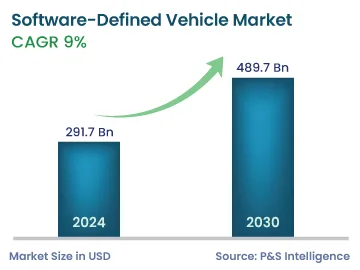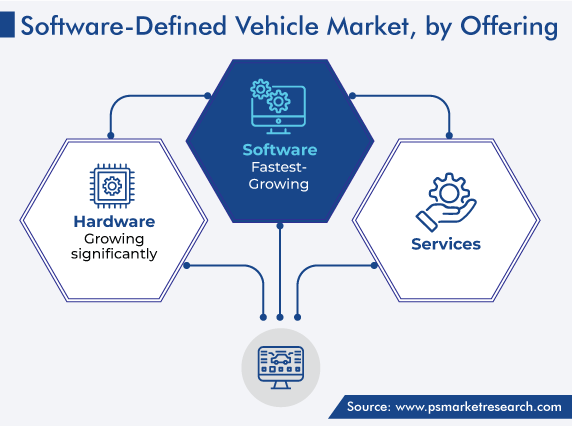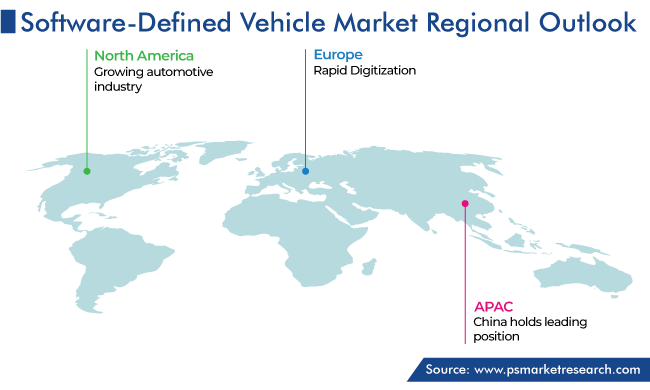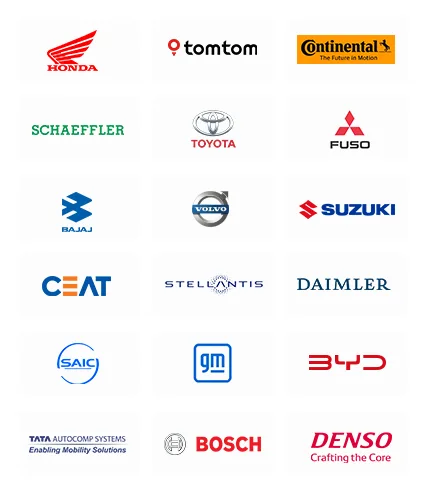Market Statistics
| Study Period | 2019 - 2030 |
| 2024 Market Size | 291.7 Billion |
| 2030 Forecast | 489.7 Billion |
| Growth Rate(CAGR) | 9% |
| Largest Region | Asia-Pacific |
| Fastest Growing Region | North America |
| Nature of the Market | Consolidated |
Report Code: 12761
Get a Comprehensive Overview of the Software-Defined Vehicle Market Report Prepared by P&S Intelligence, Segmented by Offering (Software, Hardware, Services), Vehicle Type (ICE, Electric), Application (Powertrain & Chassis, ADAS, Body & Energy, Infotainment, Connectivity & Security), Vehicle Autonomy (Level 0, Level 1, Level 2, Level 3, Level 4, Level 5), and Geographic Regions. This Report Provides Insights from 2019 to 2030.
| Study Period | 2019 - 2030 |
| 2024 Market Size | 291.7 Billion |
| 2030 Forecast | 489.7 Billion |
| Growth Rate(CAGR) | 9% |
| Largest Region | Asia-Pacific |
| Fastest Growing Region | North America |
| Nature of the Market | Consolidated |

Explore the market potential with our data-driven report
The software-defined vehicle market size stands at an estimated USD 291.7 billion in 2024, and it is expected to advance at a compound annual growth rate of 9.0% during 2024–2030, to reach USD 489.7 billion by 2030.
The growth can be primarily ascribed to the need for a reduction in the number of accidents and the advantages these automobiles offer for the elderly and people with disabilities. Essentially, advanced software enhances the safety of automobiles and minimizes the chances of the errors caused by humans. It also helps reduce the burden on the driver, by handling many of the driving functions itself.
There is a wide application of infotainment systems in automobiles as they help communicate with monitoring systems and equip a driver with information for smart routing. The system further helps in multimedia streaming, enables security and superior driving control, and offers smarter navigation options, hands-free calling, and mobile app support.
Moreover, the software updates automatically due to the adoption of a central cloud with local edge computing systems. Additionally, on the basis of the vehicle’s location, tolls could be charged automatically, thus eliminating the requirement of physical barriers for paying toll and recognizing the licensing plate. Similarly, cameras and other sensors are used for improving weather reporting and offering security to the automobile.
Software is expected to grow at the highest CAGR of 9.5%, attributed to the various advantages it offers, such as a more-convenient driving experiences and increased protection. The surge in the need for software-defined cars is mostly due to the rising need for security and the growing sale of EVs.
Among software, the hypervisor and middleware category is growing because these programs aid in running several applications simultaneously on a single hardware device. Hypervisors are known to instantly create virtual machines, in order to easily allocate resources and meet the dynamic workload requirements, thus providing high performance. They offer energy and cost-efficiency because multiple kinds of automotive software meant for varying functionalities run on one piece of computer hardware.
In addition, the category is expected to grow significantly because this software is required for minimizing the consumption of fuel and reducing the emission of pollutants. Along with this, the rising need for digitalization and increasing the safety of both vehicles and passengers are propelling its necessity.

The ADAS category is expected to show significant growth over the coming years, ascribed to the increasing awareness among individuals of the protection of passengers and drivers. Along with this, the prices of in-car electronic safety systems are decreasing, which is allowing more people to buy vehicles integrated with them. ADAS is designed for preventing collisions on the road and notifying driversof any danger. It controls the speed and helps the vehicle maintain a safe distance from those in the front and behind. The major functionalities of ADAS are automatic emergency braking, lane departure warning, pedestrian detection, blind spot detection, traffic sign recognition, adaptive light control, automatic parking, night vision, and crosswind stabilization.
Additionally, the powertrain and chassis category is expected to grow with a CAGR of 8.7%. This is because the software for these components enhances the engine performance via the management of valve timings, fuel injection, spark timings, and warning lights. This way, it helps in keeping the system in proper working condition and increases the fuel efficiency.
Based on autonomy, level 3 is expected to grow fastest, as level 3 autonomous vehicles have the capability to detect the environment and make informed decisions for themselves. These decisions include maintaining the ideal speed as per the traffic and weather conditions. It is considered a conditionally automated level, where the driver is able to handle the automobile themselves in several situations. In January 2023, Mercedes-Benz announced the receipt of the approval of the U.S. government for level 3 driving features.
The level 1 category is also growing, as this software assists the driver with cruise control and steering. Without much intervention by the driver, a safe distance between vehicles is maintained. This level of automation also helps drivers with braking, steering, and acceleration during driving. L1 features include tire pressure monitoring, lane departure warning, adaptive front lights, and many more.
The demand for EVs is growing because of their lower running cost and no requirement for fuel, which eliminates the emission of harmful gases into the environment. Additionally, all major automotive OEMs are increasing their focus on EVs to meet the growing demand. For instance, Tata Motors will launch several new electric vehicles, such as Harrier EV, Punch EV, and Nexon EV, in 2023.
The awareness is increasing among people regarding the harmful effects of diesel and gasoline combustion, which is driving the demand for environment-friendly transportation solutions. Moreover, EV sales are increasing with the installation of charging stations around the globe. It has been expected that by 2030, 30% of the vehicles plying in India would be electric.
Asia-Pacific has the leading position in the software-defined vehicle market, and it will hold the same position in the coming years, accounting for a value of USD 147.8 billion by 2030. The growth is ascribed to the rise in the focus on safety and reducing the number of accidents.
In APAC, China holds the leading position, and it will grow at a CAGR of 8.8% during the forecast period. This is attributed to the rapid technological development in its automotive industry and the adoption of smart manufacturing to boost production.
In terms of market share, APAC is followed by Europe and North America. The increasing disposable income and growing demand for safe and convenient driving experiences are boosting the sales of software-defined vehicles around the world.
Due to human error, a large number of road accidents happen, which is fueling the market advance. According to India’s Ministry of Road Transport and Highways, every year, approximately 150,000 people die in India in road accidents, which creates a high demand for software for the safety of passengers. Additionally, the number of road accidents increased by almost 12% in 2021 from 2020.

Based on Offering
Based on Vehicle Type
Based on Application
Based on Vehicle Autonomy
Geographical Analysis
Drive strategic growth with comprehensive market analysis
The market for software-defined vehicles will reach USD 489.7 billion by 2030.
Software is the fastest-growing offering in the software-defined vehicle industry.
Self-driving automobiles are the biggest driver for the market for software-defined vehicles.
APAC holds the largest share in the software-defined vehicle industry.
MaaS is a key opportunity in the market for software-defined vehicles.
Want a report tailored exactly to your business need?
Request CustomizationLeading companies across industries trust us to deliver data-driven insights and innovative solutions for their most critical decisions. From data-driven strategies to actionable insights, we empower the decision-makers who shape industries and define the future. From Fortune 500 companies to innovative startups, we are proud to partner with organisations that drive progress in their industries.


Working with P&S Intelligence and their team was an absolute pleasure – their awareness of timelines and commitment to value greatly contributed to our project's success. Eagerly anticipating future collaborations.
McKinsey & Company
IndiaOur insights into the minutest levels of the markets, including the latest trends and competitive landscape, give you all the answers you need to take your business to new heights
We take a cautious approach to protecting your personal and confidential information. Trust is the strongest bond that connects us and our clients, and trust we build by complying with all international and domestic data protection and privacy laws
Customize the Report to Align with Your Business Objectives
Request the Free Sample Pages